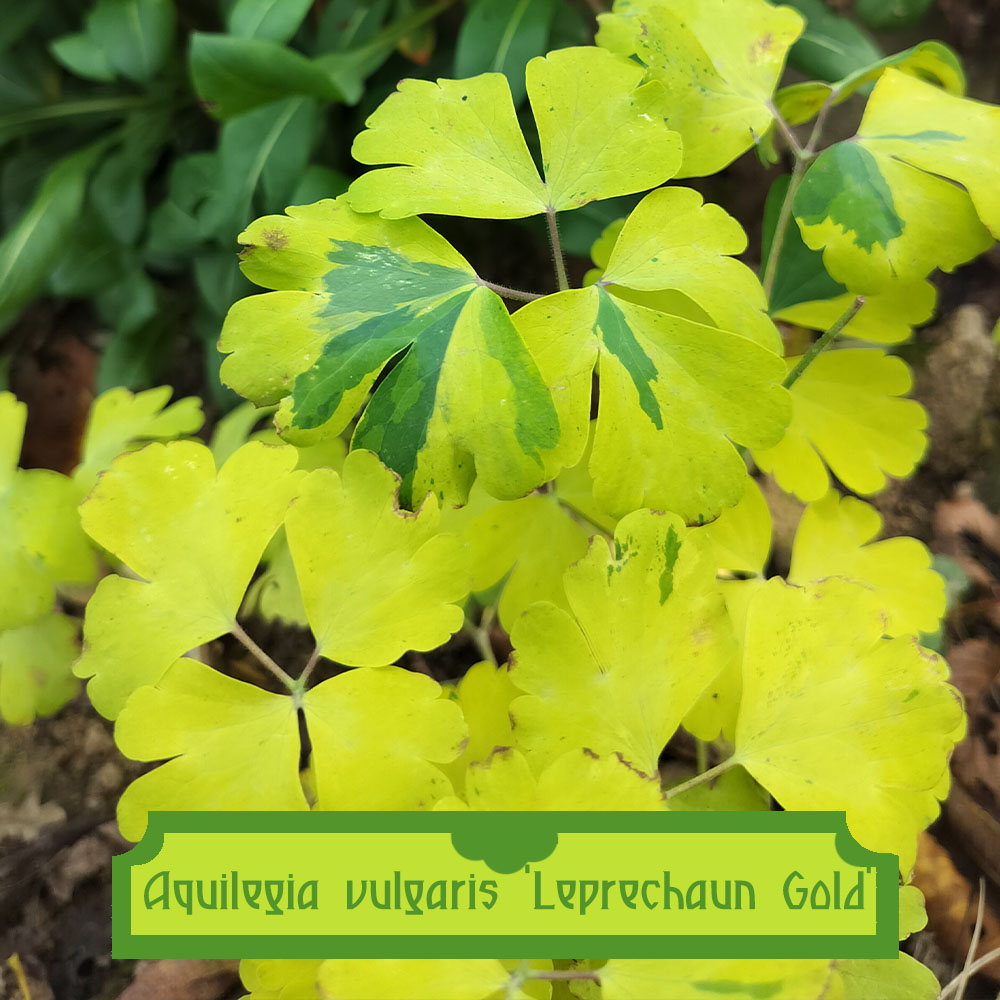-
 4,90 € × 1×€4.9
4,90 € × 1×€4.9
Customer matched zone "Locations not covered by your other zones"
“Aquilegia vulgaris Leprechaun Gold” has been added to your cart. View cart
Aquilegia vulgaris Leprechaun Gold
A light for dark corners – marbled with gold foliage.
Rated 0 out of 5
0 customer reviews
4,90 €
Only 21 item(s) left in stock!
SKU: pda513
Category: Balcony-Friendly, Bouquet, Frost Hardy, Ground Cover, Medicinal, Rewild, Self-Seeding Annual

Aquilegia vulgaris Leprechaun Gold
4,90 €
Only 21 item(s) left in stock!
Aquilegia vulgaris Leprechaun Gold is a rare and whimsical columbine whose leaves are variegated in dappled and speckled shades of yellow and neon green.
The leaves are wonderfully marbled, speckled and marbled in tones of gold, yellow and light green.
The flowers, delicate yet intricate, nod gracefully on slender stems, each bloom a miniature lantern of violet or sometimes even blue.
It thrives in almost any condition—shade, partial shade, or full sun—provided the soil is fresh and fertile.
As with all columbines, Aquilegia vulgaris Leprechaun Gold thrives in light, well-drained soil, preferring partial shade to soft morning sun.
It appreciates a cool root run and some moisture during the growing season but dislikes heavy, soggy ground.
Columbines are used as food plants by some butterfly and moth caterpillars, mainly noctuid moths, which are noted for feeding on many poisonous plants without harm.
👨🌾GARDENING TIPS👨🌾: Aquilegia vulgaris Leprechaun Gold
-
- Not drought tolerant, though readily self seeds
- It prefers ordinary, light, moist soil—its main requirement is freshness > no soggy soil please
- It thrives in both sunny and shaded locations.
- ✂️After flowering, cut back the spent blooms to encourage a light second flush and help maintain the vigor of the plant.
- Looks great with Ajuga reptans ‘Atropurpurea’‘, Persicaria ‘Red Dragon’, Festuca glauca
- 🚩Aquilegia seeds and roots are poisonous and will cause stomach irritation if ingested.
Learn more about gardening with Columbine:
The Tale & The Botany: Aquilegia vulgaris Leprechaun Gold
The genus name Aquilegia comes from the Latin aquila, meaning “eagle,” a reference to the curved spurs of the petals that resemble an eagle’s talons.
Another possible etymology for Aquilegia is a derivation from the Latin aquam legere (“to collect water”), aquilegium (a container of water), or aquilex (“dowser” or “water-finder”) in reference to the profusion of nectar in the spurs.
The most common English-language name, columbine, likely originates in the dove-like appearance of the sepals – the word for dove in Latin is columba.
Evolutionary varied, it was found that Sierra columbine and Crimson columbine each have specifically adapted pollinators, with hawk moths that can pollinate one species usually failing to pollinate the other.
As of 2025, the Royal Botanic Gardens, Kew’s Plants of the World Online accepts 130 species
Floral Morphology
The flowers generally have five sepals and five petals, with the petals often forming nectar spurs (tubular extensions that angle or curve backward) that contain nectar.
Some columbine flowers “nod” downward; others are more horizontal or outward facing, depending on species and cultivar
Leaves are “biternate” (i.e. twice ternately divided) at the base, and upper leaves divided into lobed leaflets.
Reproductive Biology
Aquilegia vulgaris Leprechaun Gold readily self-seeds, sometimes passing on its magical foliage pattern to its seedlings — but not all will inherit the gold.
Generally, Aquilegia tend to cross-pollinate, hybridize and self-seed freely, creating new strains and colors.
It is best to regularly deadhead flowers as the formation of seeds shortens the productive life span of the plant.
Columbines have a life span of about three to four years.
Ecology
Evolutionary changes in spur length and flower color are often responses to available pollinators in a region (e.g. moths, hummingbirds, bees).
Most aquilegia are deciduous but in milder climates can keep their foliage over the winter.
Columbines are rather susceptible to powdery mildew and rust spots > ensuring that the soil is well drained and that the watering is consistent (avoid overhead) will help solve these problems
Pests are most likely to be aphids and caterpillars.
Zones 3-8.
Other names
Columbine
Origin
Europe
| Weight | 0,5 kg |
|---|---|
| Flower Color | 🟣 Purple |
| Flowering | May, June |
| Soil | Cool, Clay, Clay-Silt |
| Exposure | Full Sun, Half Sun/Half Shade |
| Frost Tolerance | -20°C to -25°C |
| Size | 0.5m H x 0.4m W |
Reviews
0
Rated 0 out of 5
0 customer reviews
5
0
4
0
3
0
2
0
1
0
Only logged in customers who have purchased this product may leave a review.
You may also like…
Phlox amplifolia
A tall plant with large fragrant and edible flowers
A tall plant with large fragrant and edible flowers
Rated 0 out of 5
Delphinium requienii
Lilac-metallic flowers on tall spires
Lilac-metallic flowers on tall spires
Rated 0 out of 5
Glechoma hederacea
A sweet smelling ground cover, producing little blue flowers all summer long.
A sweet smelling ground cover, producing little blue flowers all summer long.
Rated 0 out of 5
Vinca minor
Looping elegance and ability to form a low flowering ground cover
Looping elegance and ability to form a low flowering ground cover
Rated 0 out of 5
Related Products
Sedum album
A low, multi-color ground cover.
A low, multi-color ground cover.
Rated 0 out of 5
Echinacea purpurea
A perennial with purple flowers all summer long
A perennial with purple flowers all summer long
Rated 0 out of 5
Trachelospermum asiaticum ‘Ogon Nishiki’
Jasmine with colorful foliage and lovely white flowers in summer
Jasmine with colorful foliage and lovely white flowers in summer
Rated 0 out of 5
Mentha x piperita ‘Chartreuse’
A spicy mint, known for its use in the production of liqueurs and herbal teas.
A spicy mint, known for its use in the production of liqueurs and herbal teas.
Rated 0 out of 5
Kalanchoe daigremontiana
A toothy succulent from Madagascar, known as the Mother of Thousands.
A toothy succulent from Madagascar, known as the Mother of Thousands.
Rated 0 out of 5
Tanacetum densum subsp amani
A shrublet composed of soft, finely divided silvery gray-white leaves.
A shrublet composed of soft, finely divided silvery gray-white leaves.
Rated 0 out of 5
Melissa officinalis
A perennial plant in the mint family that is adored by bees, royal families and tea drinkers.
A perennial plant in the mint family that is adored by bees, royal families and tea drinkers.
Rated 0 out of 5
Euphorbia myrsinites
Known for its draping form of silver-gray foliage and radiant blooms.
Known for its draping form of silver-gray foliage and radiant blooms.
Rated 0 out of 5
Potentilla anserina
A distinctly silvery, silky and lacy perennial.
A distinctly silvery, silky and lacy perennial.
Rated 0 out of 5
Erigeron kavinskianus
A daisy-like carpet of flowers
A daisy-like carpet of flowers
Rated 0 out of 5
Delosperma cooperi
A dwarf perennial known for its vermillion colored flowers
A dwarf perennial known for its vermillion colored flowers
Rated 0 out of 5
Aptenia cordifolia Variegata
A succulent plant in the iceplant family with bright carmine flowers.
A succulent plant in the iceplant family with bright carmine flowers.
Rated 0 out of 5
Euphorbia cyparissias Clarice Howard
A Euphorbia that resembles a soft little cyprus tree
A Euphorbia that resembles a soft little cyprus tree
Rated 0 out of 5
Stachys byzantina
Silky white-grey leaves and tall striking flowers
Silky white-grey leaves and tall striking flowers
Rated 0 out of 5
Tradescantia Blushing Bride
Gorgeous blushes of pink and white that appear in the coldest nights.
Gorgeous blushes of pink and white that appear in the coldest nights.
Rated 0 out of 5
Cerastium tomentosum var. columnae
A grey-green spreading ground cover from the mountains.
A grey-green spreading ground cover from the mountains.
Rated 0 out of 5
Hellebore argutifolius
Winter flowering perennial with marbled blue-green leaves
Winter flowering perennial with marbled blue-green leaves
Rated 0 out of 5
Hieracium maculatum Leopard
A native perennial with blue-green leaves and a tall yellow flower
A native perennial with blue-green leaves and a tall yellow flower
Rated 0 out of 5
recent view product
Leonotis leonurus
Known for its magnificent orange flowers and fragrant leaves
Known for its magnificent orange flowers and fragrant leaves
Rated 0 out of 5
Chrysanthemum Dernier Soleil
A perennial with large yellow flowers tipped with coppery-orange hues
A perennial with large yellow flowers tipped with coppery-orange hues
Rated 0 out of 5
Tanacetum vulgare Isla Gold
A bright yellow medicinal and fragrant perennial herb
A bright yellow medicinal and fragrant perennial herb
Rated 0 out of 5
Thymus longicaulis ‘Odoratus’
A fast-growing ground cover with strongly aromatic leaves, and bright pink flowers in early summer.
A fast-growing ground cover with strongly aromatic leaves, and bright pink flowers in early summer.
Rated 0 out of 5
Allium senescens subsp. montanum
Mountain garlic with pink pompom flowers
Mountain garlic with pink pompom flowers
Rated 0 out of 5




















































There are no reviews yet.